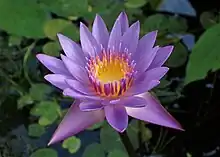

Utpala in Sanskrit is a neuter noun with two meanings, both given by Amarakoṣa (a lexicon of circa. 400 AD). The first meaning is Nymphaea nouchali, the "blue lotus", also known as kuvalaya in Sanskrit.[1][2] The second meaning of utpala is a variety of medicinal plant known as 'kooṭh' in Hindi and 'kusṭham, vyādhi, paribhavyam or pāribhavyam, vāpyam, pākalam' according to Amarkośa.[3][4][5][6]
In Buddhist art the utpala flower is an attribute of the goddess Tara, who very often holds one in her hand,[7] as other Buddhist and Hindu figures may also do. Later, the utpala becomes specific to the Green Tara form, while the White Tara holds a white lotus flower (probably Nymphaea lotus).[8] In Tibet, where none of the tender aquatic plants that may be known as lotus can grow, utpala became a general term for all of them.[9]
Monier-Williams gives the following meanings of utpala: (1) the blossom of the blue lotus Nymphaea nouchali (-Mahābhārata, Rāmāyana, Suśruta, Raghuvamsa, Meghdoota, etc.),(2) a seed of Nymphaea nouchali (-Suśruta), (3) the plant Costus speciosus (-Bhagavata Purāna), (4) any water-lily, any flower, (-lexicons) (5) a particular hell (-Buddhist literature), (6) name of a Nāga, (7) names of several persons, including an astronomer, (8) its feminine form utpalā meant a river (-Harivamśa), (9) its feminine form utpalā also meant a kind of cake made of unwinnowed corn (-lexicons);
An unrelated homonym, compounded from ud "apart" + pala "flesh" means 'fleshless, emaciated' (-lexicons) and is the name of a particular hell (-lexicons).
Notes
- ↑ Amarakoṣa 1.10.37
- ↑ For electronic edition of Amarakoṣa definition see: .
- ↑ Amarakoṣa 2.4.126
- ↑ For electronic edition of Amarakoṣa definition see: .
- ↑ Khare, C. P. (27 June 2011). Indian Herbal Remedies: Rational Western Therapy, Ayurvedic and Other Traditional Usage, Botany. Springer Science & Business Media. p. 456. ISBN 978-3-642-18659-2.
- ↑ Caraka Saṃhitā. Sri Satguru Publications. 1996. p. 766. ISBN 978-81-7030-491-3.
- ↑ Donaldson, Thomas Eugene, Iconography of the Buddhist Sculpture of Odisha, p. 356, 2001, Abhinav Publications, ISBN 81-7017-375-2, google books
- ↑ Getty, Alice, The Gods of Northern Buddhism: Their History and Iconography, p. 120, 1988 (reprint), Dover Pictorial Archive Series, Courier Corporation, ISBN 0486255751, 9780486255750, google books
- ↑ Beer, Robert, The Handbook of Tibetan Buddhist Symbols, p. 170, Serindia Publications, Inc., ISBN 1932476032, 9781932476033, google books
References
- Monier-Williams, Monier (1899), A Sanskrit-English Dictionary, Delhi: Motilal Banarsidass.
- Śāstri, Hargovinda (1978), Amarkoṣa with Hindi commentary, Vārānasi: Chowkhambā Sanskrit Series Office